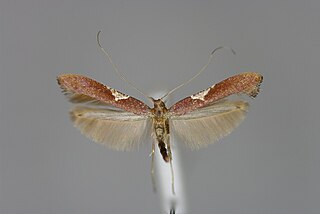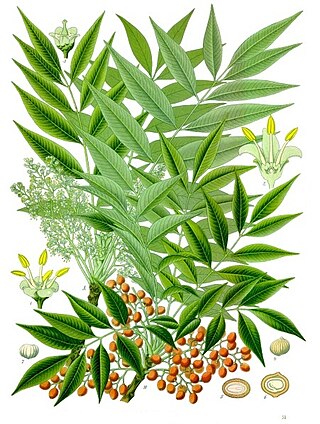
Epimedium, also known as barrenwort, bishop's hat, fairy wings, horny goat weed, or yin yang huo, is a genus of flowering plants in the family Berberidaceae. The majority of the species are endemic to China, with smaller numbers elsewhere in Asia, and a few in the Mediterranean region.

The genus Ptiloris consists of four allopatric species of birds in the family Paradisaeidae. These birds of paradise are commonly known as riflebirds, so named for the likeness of their black velvety plumage to the uniform of the Rifle Brigade. Alternatively, the bird's cry is similar to a rifle being fired and hitting its target but a call like this is not commonly reported. They are distributed in the rainforests of New Guinea and Eastern Australia.

Caloptilia is a genus of moths in the family Gracillariidae.

Caloptilia betulicola, the red birch slender, is a moth of the family Gracillariidae. It is found from Scandinavia and the north of European Russia to the Pyrenees and Alps and from Ireland to Poland and Slovakia. In the east it is found up to China, Japan and the Russian Far East.

Caloptilia stigmatella is a moth of the family Gracillariidae. It is known from the Holarctic Region, including all of Europe.
Caloptilia acericola is a moth of the family Gracillariidae. It is known from Japan and the Russian Far East.
Caloptilia heringi is a moth of the family Gracillariidae. It is known from Japan (Hokkaidō) and the Russian Far East.
Caloptilia hidakensis is a moth of the family Gracillariidae. It is known from the islands of Hokkaidō and Honshū in Japan and from the Russian Far East.
Caloptilia wakayamensis is a moth of the family Gracillariidae. It is known from Honshū island, Japan.
Caloptilia semifasciella is a moth of the family Gracillariidae. It is known from the islands of Hokkaidō, Honshū and Kyūshū in Japan.
Caloptilia gloriosa is a moth of the family Gracillariidae. It is known from Japan and the Russian Far East.
Caloptilia ryukyuensis is a moth of the family Gracillariidae. It is known the Ryukyu Islands of Japan.
Caloptilia alni is a moth of the family Gracillariidae. It is known from China, Japan, Korea and the Russian Far East.
Caloptilia isochrysa is a moth of the family Gracillariidae. It is known from the state of Meghalaya in India, the islands of Honshū, Kyūshū and Ryukyu in Japan and from Nepal.
Caloptilia schisandrae is a moth of the family Gracillariidae. It is known from China (Zhejiang), Japan, Korea and the Russian Far East.
Caloptilia kisoensis is a moth of the family Gracillariidae. It is known from Japan (Honshū), Korea and the Russian Far East.
Caloptilia pyrrhaspis is a moth of the family Gracillariidae. It is known from China (Sichuan), Japan and the Russian Far East.
Caloptilia ulmi is a moth of the family Gracillariidae. It is known from China, Japan and the Russian Far East.

Toxicodendron succedaneum, the wax tree, Japanese Hazenoki tree, sơn in Vietnamese or charão in Portuguese, is a flowering plant species in the genus Toxicodendron found in Asia, although it has been planted elsewhere, most notably Australia and New Zealand. It is a large shrub or tree, up to 8 m tall, somewhat similar to a sumac tree. Because of its beautiful autumn foliage, it has been planted outside Asia as an ornamental plant, often by gardeners who were apparently unaware of the dangers of allergic reactions. It is now officially classified as a noxious weed in Australia and New Zealand. It is one of the city tree symbols of Kurume, Fukuoka, Japan.

Epimedium pinnatum is a species of flowering plant in the barberry family Berberidaceae, native to northern Iran. It is a slowly-spreading evergreen perennial growing to 30 cm (12 in) tall and broad, with oval hairy leaves and bright yellow spurred flowers in late spring and early summer.






